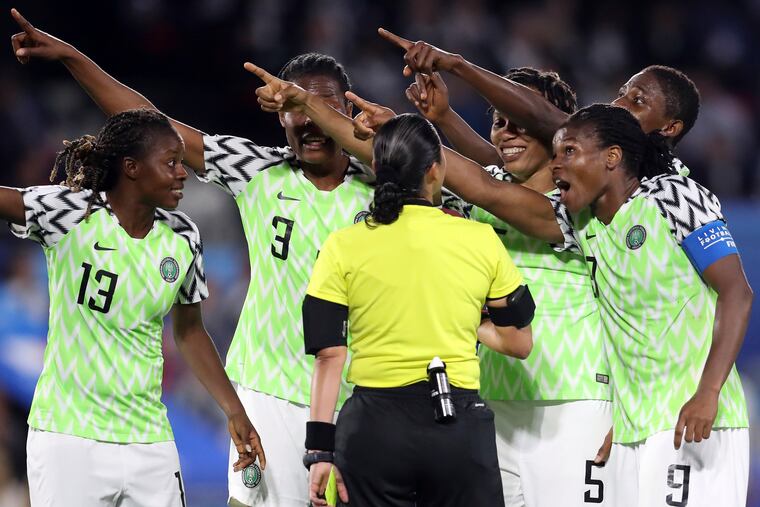Video replay has enhanced sports — and ruined them | Bob Ford
The problem with replay came when it went from being a part of the broadcasts to actually being a part of the games.

On March 24, 1962, after winning the world welterweight championship by knockout over Benny “Kid” Paret in the 12th round, Emile Griffith went to the ringside broadcast location of ABC’s Fight of the Week and watched a replay of the final minutes of the fight with announcer Don Dunphy.
The significance of the fight itself has overshadowed the interview that followed, and for good reason. Paret, who was carried out of the ring on a stretcher, never regained consciousness and died 10 days later. The tragedy significantly reduced the greater public’s appetite for the sport, and, six months later, led to the cancellation of Fight of the Week. In some ways, boxing never recovered as a sport of the masses.
Television was never the same after that night, either. The post-match interview included what is considered the first successful — albeit brutal — use of slow-motion replay on a national broadcast. Within a few years, replay technology advanced rapidly, and giving the viewers a second look at big plays or controversial decisions became ingrained in the telecast of every sport.
“Instant replay,” as it was dubbed, is great. Who can imagine watching sports without it? The technology is credited for making the NFL as popular as it is today, and there is obviously no going back. Even if it didn’t exist as a broadcast tool, every viewer can create his own replays with the flick of a DVR arrow.
There are unintended consequences with every advance, however, and instant replay now has the distinction of simultaneously enhancing sports while also ruining them. It was brilliant that the Chinese figured out how to turn sulphur into gunpowder, and if they hadn’t, someone would have, but, man, gunpowder has caused problems. The march of technology leaves a lot of ruts in the road.
The problem with replay came when it went from being a part of the telecasts to actually being a part of the games. Using replays to review decisions made by umpires, referees, and officials is totally understandable on one level — let’s have a fair outcome by getting the calls right — but it also removes the human element of those outcomes and introduces a tyranny of technology.
And, by the way, it doesn’t always help. The NFL still can’t decide what is a legitimate reception and what is pass interference, and replays have done nothing but exacerbate that failing. It would be better if the officials simply made a call and that was that. If it looks bad on replay, so what? Over the course of years, we can probably agree that every team will benefit approximately equally to the times it is aggrieved.
The Women’s World Cup currently taking place has been a hash of poorly executed replay rulings made by its Video Assistant Referee system. It was so bad in terms of not keeping with the spirit and reality of how the game is actually played that the organizers changed the rules in the middle of the tournament.
Goalkeepers are supposed to keep at least one foot on the goal line while a penalty kick is being taken, until the ball is struck. This prevents the keepers from lunging forward and unfairly limiting the shooter’s angle.
It is a good rule (it used to be both feet), but before VAR, it was also a judgment call. The referee had the discretion to overlook some drifting off the line if he or she chose, particularly if it didn’t appear to affect the outcome of the shot. The United States might not have won its historic 1999 World Cup if keeper Briana Scurry hadn’t charged about six feet off the line to stop a China penalty kick.
That infraction wouldn’t have flown this year, as VAR has nitpicked the goalkeeper’s positioning on every PK. If there is one blade of grass between the keeper’s heel and the goal line, the encroachment is called. Karen Bardsley, England’s goalkeeper, termed the video-replay rulings “cruel and pedantic.”
Encroachment on missed shots is penalized with a second try for the shooter and with a yellow card given to the goalkeeper. Soccer officials realized that once the tournament went from group play (where a tie can result) to knockout play (where tie games go to penalty kicks), goalkeepers would probably be kicked out of the match for receiving two yellow cards. And not necessarily because they did anything overt, but because the VAR system leaves no room for judgment.
So, that’s right, they changed the rules of soccer between group play and knockout play. An encroachment violation in the overtime penalty-kick round is no longer punished by a yellow card in this tournament.
It is the World Cup’s way of saying the technology is so good that it is bad. Other sports are suffering the same sort of unintended consequences, leaving aside the sapping delays caused by the official reviews. The results might be better — although not always — but the games are worse.
Sports played by humans should be officiated by humans. It’s that simple. If we can live with a fielder dropping an occasional fly ball, we should be able to live with a bang-bang missed call at first base. Trying to achieve perfection in an imperfect world never works, and there are centuries of history that can be replayed and reviewed to prove that.